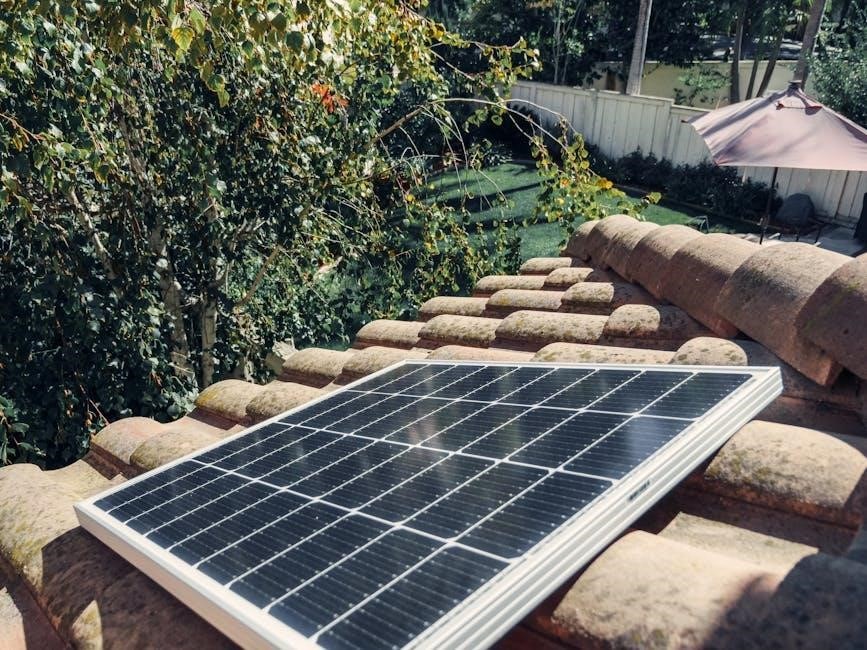
Homemade batteries offer an eco-friendly, cost-effective solution using inexpensive materials. Learn the science behind creating powerful batteries through simple electrochemical reactions and optimize energy storage effectively.
Overview of Homemade Battery Technology
Homemade battery technology involves creating energy storage devices using readily available materials. By leveraging electrochemical reactions between metals and electrolytes, individuals can craft batteries for various applications. These DIY solutions often utilize aluminum, copper, and common household chemicals to generate power. The simplicity of these designs makes them accessible to enthusiasts, offering a cost-effective alternative to commercial batteries. This approach not only promotes sustainability but also encourages experimentation and innovation in energy storage solutions.

Benefits of Building a Powerful Homemade Battery
Constructing a homemade battery offers several advantages, including reduced costs and environmental impact. DIY methods allow customization to meet specific power needs, enhancing energy efficiency. These batteries can be scaled for various applications, from small devices to home systems. Additionally, building your own battery fosters a deeper understanding of electrochemistry and sustainability. This approach also promotes self-reliance and innovation, making it an appealing option for eco-conscious individuals and hobbyists alike.

Materials and Tools Required
Essential materials include aluminum, copper, water, bleach, and silicon. Tools like drills, pliers, and safety gear are necessary for assembly and electrolyte handling.
Basic Components of a Homemade Battery

A homemade battery typically consists of electrodes made from materials like aluminum or copper, an electrolyte solution such as water mixed with bleach, and insulation materials like silicon or tape. The electrodes act as the positive and negative terminals, while the electrolyte facilitates the chemical reaction. A non-conductive container is used to house these components, ensuring safety and efficiency. These basic elements work together to generate electrical energy through electrochemical reactions, making homemade batteries a viable option for small-scale energy needs.
Specialized Materials for High-Power Batteries
High-power homemade batteries often utilize lithium-ion cells, such as 18650 batteries, for their high energy density and discharge capabilities. These cells, commonly repurposed from EVs or electronics, provide superior performance. Specialized electrolytes and advanced insulation materials, like silicon, enhance safety and efficiency. For high-power applications, RC lipo batteries are preferred due to their ability to sustain extreme discharge rates. These materials enable homemade batteries to deliver the energy required for demanding devices, making them suitable for scalable energy storage solutions and high-performance needs.

Safety Precautions and Guidelines
Always wear protective gear and ensure proper ventilation when handling chemicals. Follow safety guidelines to avoid hazards and ensure secure handling of materials and equipment.
Handling Electrolytes and Chemicals Safely
Handling electrolytes and chemicals requires extreme caution to prevent accidents. Always wear protective gloves, goggles, and a face mask to avoid skin and eye contact. Ensure proper ventilation to prevent inhaling harmful fumes. Keep flammable materials away from the workspace and store chemicals in sealed containers. Never mix incompatible substances, as this can cause dangerous reactions. Follow the recommended safety guidelines for each chemical and dispose of waste responsibly. Avoid tasting or touching unknown substances, and keep a fire extinguisher nearby. Always consult safety data sheets for specific handling instructions.
Protective Gear and Workspace Setup
Setting up a safe workspace is crucial when building homemade batteries. Always wear protective gear, including goggles, gloves, and a face mask, to prevent exposure to harmful chemicals. Ensure the workspace is well-ventilated to avoid inhaling fumes. Clear the area of flammable materials and keep a fire extinguisher nearby. Use heat-resistant surfaces and organize tools neatly to minimize accidents. Properly label and store all materials. A clean, stable workspace ensures better focus and reduces risks during the assembly process. Keep emergency contact information within reach for quick assistance if needed.

Understanding Battery Chemistry
Batteries rely on electrochemical reactions between electrodes and electrolytes. Positive and negative terminals facilitate energy flow, while electrolytes enable ion transfer, driving electrical current for power generation.
Electrochemical Reactions in Batteries
Batteries function through electrochemical reactions where chemical energy converts to electrical energy. The positive terminal (anode) undergoes oxidation, releasing electrons, while the negative terminal (cathode) gains electrons, enabling current flow. Electrolytes facilitate ion transfer between electrodes. In homemade batteries, zinc and copper electrodes in an acid solution (like vinegar) create voltage. This reaction powers devices, demonstrating how simple materials can generate energy. Understanding these principles is key to designing efficient, powerful homemade batteries for various applications.
Role of Electrodes and Electrolytes
Electrodes and electrolytes are crucial in battery operation. Electrodes, made of conductive materials like zinc and copper, act as terminals for chemical reactions. The anode (negative electrode) oxidizes, releasing electrons, while the cathode (positive electrode) reduces, accepting electrons. Electrolytes, such as weak acids or salts, facilitate ion transfer between electrodes, enabling current flow. In homemade batteries, vinegar often serves as the electrolyte, connecting zinc and copper electrodes to generate voltage. This synergy between electrodes and electrolytes is essential for converting chemical energy into electrical energy, powering devices efficiently.

Step-by-Step Assembly Guide
Gather materials like aluminum, copper, and vinegar. Assemble electrodes and electrolytes, ensuring proper insulation. Follow detailed instructions to connect components safely and test the battery’s power output effectively.
Building a Simple Water Cell Battery
Start by gathering materials like aluminum foil, copper wire, and a container. Mix water with a small amount of bleach or vinegar to create the electrolyte. Submerge the electrodes, ensuring they don’t touch to avoid short circuits. Use cardboard or plastic for separation. Connect the electrodes to a low-voltage device, such as an LED light, to test the battery’s power. Be cautious to avoid electric shocks and ensure proper cleanup. Experiment with different electrolyte concentrations and electrode materials to optimize performance. This project offers a hands-on lesson in basic electrochemistry and encourages creative reuse of household items for educational DIY experiments.
Constructing a High-Power Lithium-Ion Battery
Building a high-power lithium-ion battery involves repurposing 18650 lithium cells, often sourced from electric vehicles or laptops. Begin by testing cell capacity and voltage using specialized tools. Wear protective gear, including gloves and goggles, to handle potentially hazardous materials; Arrange cells in series or parallel to achieve desired voltage and capacity. Use a battery management system (BMS) for safety and efficiency. Insulate connections with electrical tape and ensure proper ventilation. This method allows for scalable energy storage, suitable for powering devices like laptops or even small vehicles, while promoting eco-friendly energy solutions.

Optimizing Battery Performance
Optimizing battery performance involves enhancing electrolytes, refining electrode materials, and improving internal structure. Regular testing and refining ensure maximum energy output and prolonged lifespan.
Testing and Refining Your Homemade Battery
Testing involves measuring voltage, current, and capacity using multimeters. Refining includes experimenting with electrode materials, electrolytes, and configurations to enhance performance. Iterative adjustments ensure reliability and efficiency, optimizing energy storage and output for various applications. Proper documentation of results helps identify patterns and improvements, crucial for achieving a powerful homemade battery. Regular testing also ensures safety by identifying potential weaknesses or hazards early in the process. This iterative cycle is key to creating a reliable and efficient battery system.
Enhancing Energy Storage Capacity
To enhance energy storage capacity, consider increasing the number of battery cells or optimizing their configuration. Using high-surface-area electrodes and stronger electrolytes can improve charge density. Experimenting with advanced materials, such as lithium-based compounds, boosts energy retention. Proper insulation and reduced internal resistance also maximize stored energy. Regular testing ensures optimal performance, while refining designs based on results further enhances capacity. These strategies help create a more powerful and efficient homemade battery, suitable for larger energy demands and extended use in various applications. This approach ensures reliable energy storage solutions tailored to specific needs.

Practical Applications of Homemade Batteries
Homemade batteries can power small devices, vehicles, and home lighting, offering versatile energy solutions. They provide efficient storage for renewable energy systems, supporting eco-friendly power needs effectively.
Powering Small Devices and Appliances
Homemade batteries are ideal for powering small devices like smartphones, LED lights, and RC toys. They provide a reliable energy source for low-voltage appliances, ensuring efficient performance. By scaling the battery’s power, you can customize it to meet specific energy needs, making it suitable for a variety of applications. This eco-friendly solution reduces reliance on commercial batteries, offering a cost-effective and sustainable way to power everyday electronics and small appliances with minimal environmental impact.
Scaling Up for Larger Energy Needs
Homemade batteries can be scaled to meet larger energy demands by combining multiple cells or using high-capacity materials. DIY enthusiasts have successfully created systems like Peter Matthews’ 40-kilowatt-hour setup using 4,480 lithium-ion cells. Repurposing electric vehicle batteries is another growing trend, offering a sustainable way to store energy for homes and vehicles. This approach reduces waste and lowers costs, making renewable energy solutions more accessible. By leveraging innovative techniques and readily available components, homemade batteries are becoming a viable option for larger-scale energy needs.
Homemade batteries offer sustainable, cost-effective energy solutions. Advancements in DIY technology empower individuals to create eco-friendly power sources, reducing reliance on industrial products and fostering innovation.
Advancements in DIY Battery Technology
Recent advancements in DIY battery technology have enabled individuals to create high-performance energy storage solutions using recycled materials. Innovators are repurposing electric vehicle batteries and experimenting with lithium-ion cells to achieve greater power density. Homemade batteries now incorporate advanced chemistries, such as lithium-iron-phosphate, for improved safety and efficiency. The rise of online communities and forums has accelerated knowledge sharing, allowing enthusiasts to optimize designs and push the boundaries of DIY energy storage. These innovations not only reduce costs but also promote sustainability by repurposing discarded battery cells.
Environmental and Cost Benefits of Homemade Batteries
Homemade batteries offer significant environmental benefits by reducing electronic waste and promoting the reuse of materials. Repurposing old or recycled components minimizes the need for new resources, making the process more sustainable. Additionally, homemade batteries can be cost-effective, as they often use inexpensive, readily available materials. This DIY approach not only lowers expenses but also empowers individuals to create energy storage solutions tailored to their needs, fostering innovation and self-sufficiency while contributing to a greener planet.